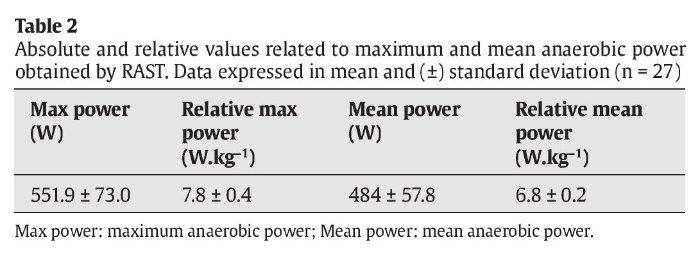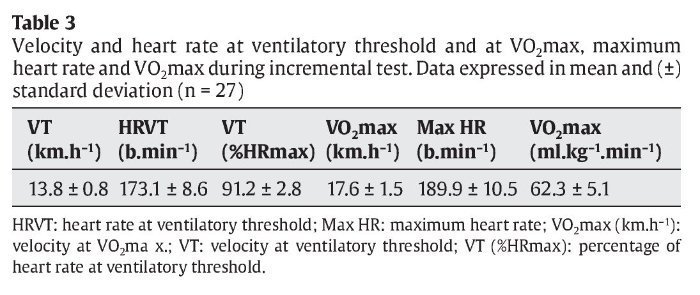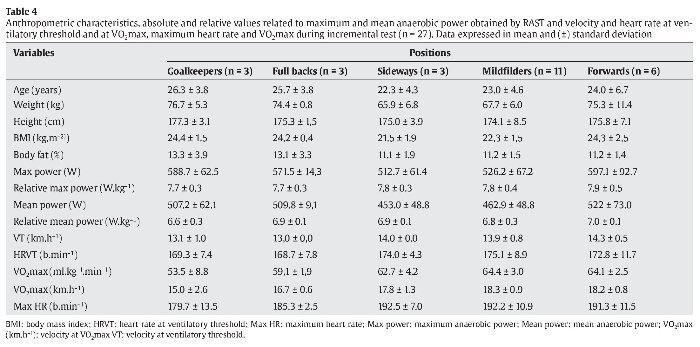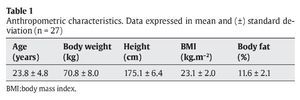Objetivo. Describir el perfil antropométrico y la aptitud física de los jugadores de fútbol de élite que trabajan en los Emiratos Árabes Unidos.
Métodos. Veintisiete jugadores de fútbol de élite que trabajan en los Emiratos Árabes Unidos fueron some-tidos a una evaluación antropométrica, un test incremental en un tapiz rodante y Running-Based Anaerobic Test (RAST).
Resultados. El índice de masa corporal y el porcentaje de grasa fueron 23,1 ± 2,0 kg.m-2 y 11,6 ± 2,1 %, respectivamente. El consumo máximo de oxígeno (VO2máx) estimado fue 62,3 ± 5,1 ml.kg-1.min-1, y la velocidad media de VO2máx fue 17,6 ± 1,5 km.h-1, y la velocidad media de umbral ventilatorio (UV) fue 13,8 ± 0,8 km.h-1. La frecuencia cardíaca del UV fue en media 173,1 ± 8,6 b.min-1, lo que representa 91,2 ± 2,8 % de la frecuencia cardíaca máxima. El test RAST resultó en una potencia máxima absoluta de 551,9 ± 73,0 W, potencia máxima relativa de 7,8 ± 0,4 W.kg-1, potencia media absoluta de 484,0 ± 7,8 W, y potencia media relativa de 6,8 ± 0,2 W.kg-1.
Conclusión. El perfil antropométrico de los jugadores de fútbol que trabajan en los Emiratos Árabes Unidos es similar a otros del resto del mundo. Sin embargo, en cuanto a la aptitud física, los resultados aún no son concluyentes, porque los resultados de otros estudios sugieren que la potencia anaerobia de nuestra muestra es igual o inferior a la de otros jugadores de élite de todo el mundo. Del mismo modo, el VO2max indirecto no es concluyente, teniendo en cuenta las limitaciones reconocidas de obtener indirectamente esta variable. Finalmente, al analizar los jugadores de acuerdo con a la posición táctica, los resultados de este estudio son similares a los estudios anteriores.
Objective. To describe the anthropometric and physical fitness profiles of elite soccer players acting in the United Arab Emirates.
Method. Twenty seven elite soccer players acting in the United Arab Emirates were underwent to an anthropometric evaluation, an incremental test in treadmill and performed the Running-Based Anaerobic Test (RAST).
Results. Body mass index and body fat percentage of the athletes were 23.1 ± 2.0 kg.m-2 11.6 ± 2.1 %, respectively. Indirect maximum oxygen uptake (VO2max) was 62.3 ± 5.1 ml.kg-1.min-1, mean velocity at VO2max was 17.6 ± 1.5 km.h-1, ventilatory threshold (VT) of 13.8 ± 0.8 km.h-1, heart rate at VT of 173.1 ± 8.6 b.min-1, which represents of 91.2 ± 2.8 % of maximum heart rate. RAST resulted in a maximum absolute power of 551.9 ± 73.0 W, maximum relative power of 7.8 ± 0.4 W.kg-1, mean absolute power of 484.0 ± 57.8 W, and mean relative power of 6.8 ± 0.2 W.kg-1.
Conclusion. The anthropometric profile of soccer players that act in the United Arab Emirates is similar to others around the world. However, regarding the physical fitness, results are still inconclusive, since findings from other studies suggest that the anaerobic power of our sample is alike or lower than other elite players throughout the world. Likewise indirect VO2max, especially given the acknowledged limitations of obtaining indirectly this variable. In addition, making an analysis by playing position, the results of this study are similar to previous research.
INTRODUCTION
Soccer is characterized by acyclic and intermittent actions, such as high intensity sprints, jumps and kicks1. Studies have demonstrated that some physical qualities are determinant to performance in soccer2-3.
Therefore, a significant amount of studies approaching the physical and physiological aspects of professional soccer have been performed. Previous investigations4-13 have evaluated the anthopometric and physical fitness profiles of professional soccer players in most parts of Europe and America. However, there is still little descriptive data over these characteristics in elite soccer players from the Asian continent, especially in the Arab world. Characteristics such as body composition (body fat percentage and body mass index), anaerobic power (speed), aerobic power (maximum oxygen uptake), aerobic capacity (anaerobic threshold) among other factors are determinant to the development of training and the performance of professional soccer players1-2,14-18.
Thus, the better understanding of the anthropometric and physical fitness profiles of professional soccer players acting in the United Arab Emirates could provide more information to coaches and physiologists on this specific group of athletes, favoring training and, consequently, the athlete's performance. Hence, the aim of the present study was to describe the anthropometric and physical fitness profiles of elite soccer players acting in the United Arab Emirates.
METHOD
Sample
The present study has a cross-sectional, analytic and descriptive nature in which participated 27 elite soccer players acting in the United Arab Emirates (table 1). All participants were instructed to refrain from physical exercise and not to ingest alcohol or caffeine in the 24 hours that preceded the experimental procedures. After being informed of the risks and benefits of the study and gave a written informed consent, all individuals were submitted to an anthropometric evaluation, an incremental test in a treadmill, and an anaerobic power test in an athletics track. Finally, the sample was divided into five groups as follows: goal-keepers, full backs, sideways, midfield and forwards, for comparison of anthropometric variables (BMI and body fat percentage) and physical fitness (aerobic and anaerobic) between the different groups. All procedures were approved by the ethics committee of University research center UNIRG (process n° 0001/2008).
Anthropometric measurements (body mass index and boy fat percentage)
Body mass index (BMI) was calculated considering the quotient between body mass (Toledo 2096 PP, Brazil) in kilograms, and stature (SECA® 214, USA) in squared meters (kg.m-2).
Relative body fat percentage (BF%) was estimated using the skinfold thickness technique, in which body density was calculated using the 7 skinfold thicknesses protocol proposed by Jackson and Pollock19, measured three times at each point, in a rotational order, on the right side of the body, with the mean value of the measurements being registered. All procedures were performed by a single evaluator using a skinfold caliper (Lange, Cambridge Scientific Instruments, Maryland, USA). Afterwards, body density was converted in BF% using Siri's equation20.
Physical fitness
Running-Based Anaerobic Sprint Test
Determination of anaerobic power was performed using the Running-Based Anaerobic Sprint Test (RAST). The RAST test consisted of six 35 meters maximal runs separated by a period of 10 secs of passive recovery. The recorded time was conducted after every effort by a stop watch (Casio HS-80TW). Power (P), in Watts (W), for each sprint was calculated through the product of body mass (BM), in kilograms (kg), and the distance (35m) raised to the second power. Afterwards, this result was divided by the time of each sprint (T), in seconds (s), raised to the third power.
Registered anaerobic parameters of the RAST were: maximum power (Pmax; highest value in the six sprints); and mean power (Pmean; mean power in the six sprints). In addition, Pmax and Pmean values in relation to body mass (W.kg-1) of each athlete were also calculated.
Ventilatory threshold
An incremental test (IT) was performed in a treadmill (Super ATL, Imbramed, São Paulo, Brazil) at an initial speed of 7 km.h-1, followed by increments of 1 km.h-1 at each minute until volitional exhaustion. Heart rate was registered during all procedures (Polar® S810i, Polar Electro Oy, Kempele, Finland).
Ventilatory threshold (VT) was determined as the moment in which occurred an exponential increase in ventilation (VE)21 according to the ventilometer used (Flowmet, Micromed, Guará, Brasília, Brazil).
Prediction of maximal oxygen uptake (VO2max)
The equation suggested by the American College of Sports Medicine (ACSM) was used to predict VO2max, as follows: VO2 = (0.2 x mean speed in m.min-1) + 3.522.
Statistical procedures
The normality of the data was analyzed using the Shapiro-Wilk's test. Results of all investigated variables are expressed in mean and (±) standard deviation.
RESULTS
Table 1 presents the anthopometric characteristcs of the evaluated players.
RAST test showed that the evaluated players presented a maximum absolute power (Pmax) of 551.9 ± 73.0 W, maximum relative power (Pmax-relative) of 7.8 ± 0.4 W.kg-1, mean absolute power (Pmean) of 484.0 ± 57.8 W, and mean relative power (Pmean-relative) of 6.8 ± 0.2 W.kg-1 (table 2).
In addition, velocity and heart rate at ventilatory threshold, as well as at the time of exhaustion (VO2max) were also measured. The athletes presented mean velocity at VT of 13.8 ± 0.8 km.h-1, heart rate at VT of 173.1 ± 8.6 b.min-1, heart rate percentage at VT of 91.2 ± 2.8 %, maximum heart rate of 189.9 ± 10.5 b.min-1, VO2max of 62.3 ± 5.1 ml.kg-1.min-1 and mean velocity at VO2max of 17.6 ± 1.5 km.h-1 (table 3).
Lastly, all data (anthropometric and physical fitness) separated by position (goalkeepers, full backs, sideways, midfielders and forwards) are presented in table 4. No statistical comparisons were made between the different positions due to the low number of subjects in each group. However, apparently, there were no differences between the parameters of anaerobic fitness related (Pmax-relative [W.kg-1] and Pmean-relative [W.kg-1]) (table 4). On the other hand, goalkeepers and full backs have VO2max values visually inferior to their peers from other positions (mid-fielders, sideways and forwards). Furthermore, midfielders, sideways and forwards, apparently, have lower values of BMI and body fat percentage than goalkeepers and full backs.
DISCUSSION
The main findings of the present study describe the anthropometric and physical fitness profiles of elite soccer players acting in the United Arab Emirates. Regarding anthropometry, the studied sample presented similar BMI (23.10 kg.m-2) to the ones found by Al-Hazzaa et al.11 in Saudi Arabia (23.30 kg.m-2), Bangsbo23 in Denmark (23.87 kg.m-2), Bunc and Psotta24 in Czech Republic (23.58 kg.m-2), Casajús25 in Spain (24.34 kg.m-2), Faina et al.26 in Italy (23.69 kg.m-2), Helgerud et al.1 in Norway (23.18 kg.m-2), Matkovic et al.27 in Croatia (24.16 kg.m-2), Rahkila and Luthanen28 in Finland (23.35 kg.m-2), and Vanfraechem and Tomas29 in Belgium (23.41 kg.m-2), all first division teams at the time.
When comparing body fat percentage, our results (11.6 ± 2.1 BF%) agreed with the ones found by other authors, such as Prado et al.30, who found values around 11.19 BF% in 118 Brazilian soccer players, and Silva et al.31 and Santos32 whose mean values showed 11.1 ± 1,3 and 11.4 ± 2.6 BF%, respectively.
In addition, Aziz et al.33, evaluating BF% in elite player from the Singaporean League, presented similar results to the ones obtained in the present study, independently from the player's position, being 11.9 ± 2.8 for goalkeepers, 11.0 ± 2.8 for defensive players, 11.7 ± 2.0 for midfielders, and 10.9 ± 2.3 BF% for offensive players.
However, Chin et al.8 and Muniroglu and Koz34, when evaluating athletes from Hong Kong and Turkey, respectively, demonstrated lower values when compared to the ones of the present study, being 7.3 ± 3.0 BF% for the athletes from Hong Kong and 7,43 ± 1,67 BF% for the ones from Turkey. The difference found between the values exposed above could de partially explained by the dissimilar moment of evaluation in the training periodization of the investigated teams.
The evaluation of power and anaerobic capacity is of fundamental importance for the development and training of these characteristics in soccer athletes35-36.
When analyzing the Pmax and Pmean obtained in the present study, the values found were lower than others reported in previous studies, such as Santos' et al.37 and Campeiz and Oliveira's38, both investigating Brazilian players. These different results suggest that there may be intercontinental factors, such as tactic and technical skills, which can demand a more developed physical fitness when compared to Arab soccer.
However, data referring to aerobic capacity and power (VT and VO2max, respectively) presented similar or slightly higher values when compared to previous studies. Coelho et al.39 and Casajús25, for instance, found VT velocity between 12.4 ± 1.5 and 12.9 ± 1.2 km.h-1, while in the present study, the athletes presented a mean value of 13.8 ± 0.8 km.h-1. In addition, the sample from the present study reached a higher %HR-max (91.2 ± 1.2%) when compared to Chinese athletes (88.9 ± 3.9%), and similar values to Spanish players (91.0%)8,25.
Oxygen consumption levels found in the present study (62.3 ± 5.1 ml.kg-1.min-1) were below others available in the scientific literature, such as Chamari's et al.40 (66.6 ± 5.0 ml.kg-1.min-1) in players from the Turkish national team and Casajús'25 (66.4 ± 7.6 ml.kg-1.min-1) in Spanish elite players.
On the other hand, other studies approaching oxygen consumption showed results similar to the ones of the present study. Balikian et al.41, found values of VO2max of 60.28 ± 6.23 ml.kg-1.min-1 for defensive players, 61.12 ± 5.33 ml.kg-1.min-1 for wingbacks, and 61.01 ± 7.14 ml.kg-1. min-1 for midfielders. Also, when compared to elite Turkish players34 and from Hong Kong8, the present study's findings were higher (62.3 ± 5.1 ml.kg-1.min-1 vs. 56.95 ± 4.07 ml.kg-1.min-1 vs. 58.8 ± 3.3 ml.kg-1. min-1), respectively.
The analysis of anthropometric variables (BMI and body fat percentage) and physical fitness (Pmax-relative, Pmean-relative, VO2max and ventilator threshold) by position (goalkeepers, defenders, side, mid-fielders and attackers) apparently did not show differences regarding the variables of power and anaerobic capacity. Likewise, the study Moro et al.42, when comparing the average power between different positions, as well as between teams of professional level, being a team of first division in the Sagres League - Portuguese and other second division Championship Gaúcho - Brazil, found no significant differences intra-team (between positions).
Moreover, Balikian et al.41 found statistically significant difference for VO2max only between goalkeepers over the other positions, similarly to the present study, which found visual differences only between goal-keepers and full backs over the other playing positions.
It is worth highlighting that all studies presented in this discussion obtained oxygen consumption values from direct measurements, while the results found in the present study were estimated through an equation proposed by the American College of Sports Medicine22. This could be acknowledged as a limitation to the present study. Therefore, the VO2max values presented here should be analyzed with caution.
Regarding the aerobic capacity (ventilatory threshold), apparently, the data of this study are similar to those reported by Balikian et al.41, who showed that goalkeepers and full backs have a velocity of anaerobic threshold identified by onset of blood lactate accumulation (OBLA; 4mM) lower than players of other positions. This can partly be explained by the characteristic of these playing positions (goalkeepers and full backs), since goalkeepers and full backs are those covering smaller distances during a match, making this capacity need not be highly trained and developed in this group of athletes43.
On the other hand, BMI and body fat percentage are apparently higher in goalkeepers and full backs, which is in agreement with the findings of Reilly et al.44, who showed that goalkeepers and central defenders have greater body adiposity than players of other positions.
In conclusion, the results of this study indicate that the anthropo-metric profile of soccer players that act in the United Arab Emirates is similar to others around the world. However, regarding the physical fitness, results are still inconclusive, since findings from other studies suggest that the aerobic power of our sample is alike or lower than other elite players throughout the world. Furthermore, the data for the maximum oxygen consumption also seem to be inconclusive, in that the present study shows lower values than some studies, but higher than others. Moreover, the acknowledged limitations of the equation used infers that the results of this research should be interpreted with caution. In addition, making an analysis by playing position, the results of this study seem to follow the global trend, once the studies analyzed showed data similar to the present investigation.
Acknowledgement
The authors thank the Coordenação de Aperfeiçoamento de Pessoal de Nível Superior (CAPES) and Conselho Nacional de Desenvolvimento Científico e Tecnológico (CNPq) for granting the scholarships in undergraduate research level (CNPq), MSc (CAPES), PhD (CAPES and CNPq) and of productivity in research (CNPq).
Conflict of interest
The authors declare that they have no conflict of interest.
History of the article:
Received August 25, 2012
Accepted November 28, 2013
Correspondence:
M. Magalhães Sales.
E-mail:marcelomagalhaessales@gmail.com












